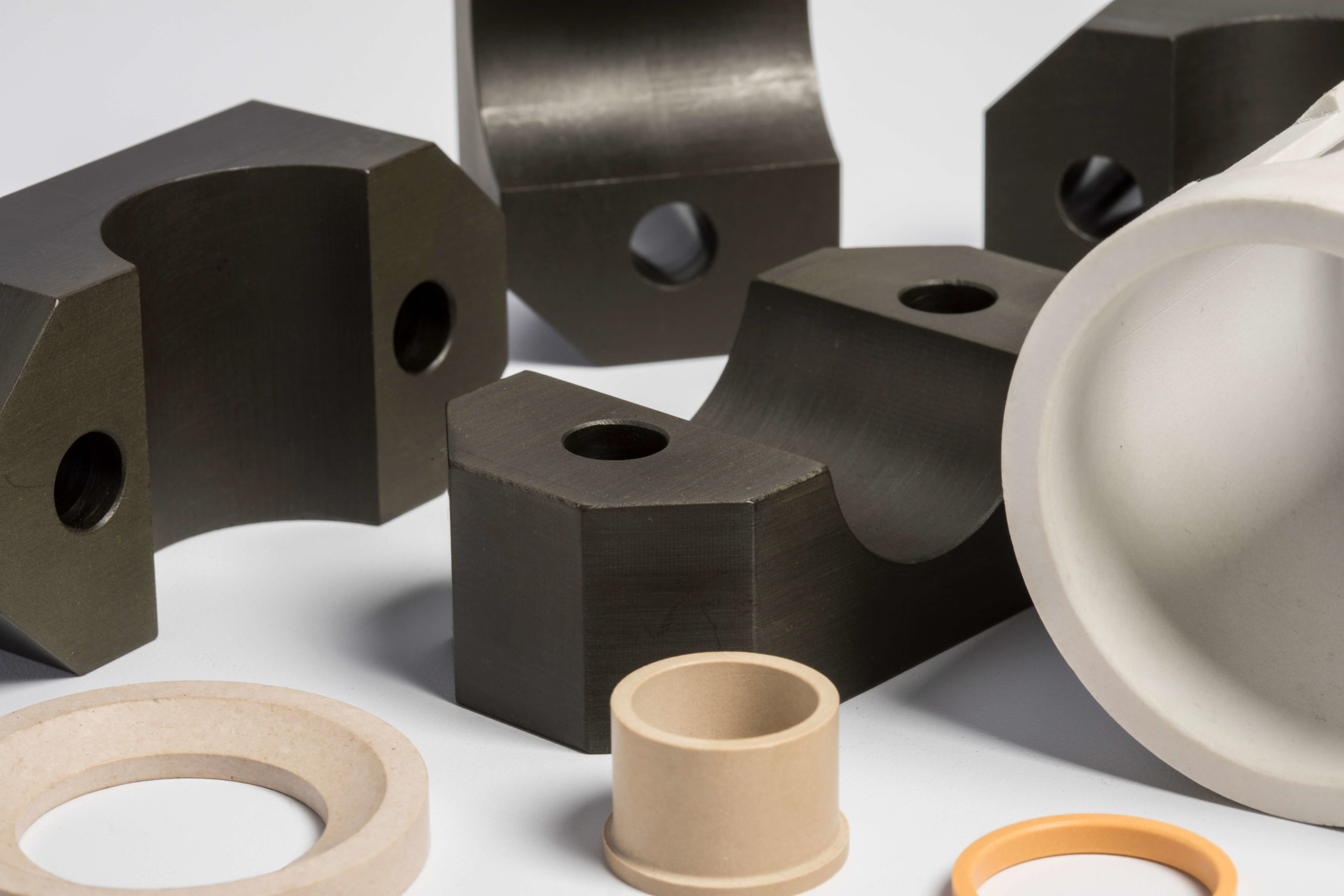Torlon bearings handle extreme loads and high heat in applications where metals and other polymers simply cannot maintain their performance. Made from ultra-strong polyamide-imide (PAI), Torlon bearings can maintain dimensional stability and low friction even under extreme stressors.
This blog post explores why Torlon bearings excel in such demanding environments, the grades they are available in, what sets them apart from other high-performance materials, and the manufacturing options available.
What Makes Torlon Different: A Polymer Built for Extremes
Torlon PAI (Polyamide-Imide) is a thermoset aromatic imide-amid polymer that was initially developed for its ultra-high molecular strength but also possesses excellent thermal performance and wear resistance.
Torlon offers continuous service temperature of up to ~500°F (260°C) with minimal creep or softening, and remains stable even when exposed to fuels, lubricants, and most industrial fluids. Torlon has low friction and does an excellent job of resisting wear against both metal and polymer counterparts. These and other properties make Torlon an excellent choice for demanding bearing environments.
Bearing Design Challenges in High-Load, High-Temperature Mechanisms
Common challenges in these environments include high PV conditions, lubrication starvation, wide temperature swings, and thermal cycling issues. All of these issues are met head-on by Torlon bearings.
There are many harsh environments that require high-load, high-temperature bearings, such as jet engine accessory drives, gear pumps, and compressors. And Torlon excels in situations where metals are prone to seize or gall, and polymers may creep or deform. From industrial ovens to downhole drilling tools, electric motors to high-speed aerospace actuators, Torlon has proven itself to be an excellent bearing solution.
Why Torlon Bearings Excel Under Pressure
Load Capacity and Strength
Torlon possesses a compressive strength that exceeds 35,000 ksi and is able to maintain stiffness even at elevated temperatures, both of which make it excellent for static and dynamic bearing loads. It is also able to retain its mechanical integrity at temperatures beyond 250°C, as well as resisting thermal fatigue and maintaining appropriate clearances in mixed-material assemblies.
Torlon is naturally self-lubricating, and its coefficient of friction can be further enhanced through internal fillers like graphite and/or PTFE. It also exhibits excellent wear rates even in dry or marginally lubricated conditions. Its low coefficient of thermal expansion improves alignment and minimizes vibration in high-speed systems. Its low coefficient of thermal expansion improves alignment and minimizes vibration in high-speed systems.
Finally, Torlon components can be injection molded, compression molded, and machined, with exceptional machinability for attaining extremely tight tolerances.
Grades and Configurations for Torlon Bearings
There are several bearing grades of Torlon available, with various fillers that each enhance key properties. These are summarized in the table below.
| Grade | Filler Type | Key Properties | Typical Applications | Performance Notes |
| Torlon 4203 | Unfilled | Highest purity and electrical properties; moderate wear | Electrical connectors, insulators | Baseline for comparison; not optimized for bearing use |
| Torlon 4301 | 12% Graphite, 3% PTFE | Excellent wear resistance and low friction; maintains strength and dimensional stability | Bushings, thrust washers, compressor bearings | Industry standard bearing grade; performs well under dry or marginally lubricated conditions |
| Torlon 4435 | Carbon Fiber + PTFE | Superior load-bearing and wear performance; higher modulus and thermal conductivity | High-load bearings, gears, seal rings | Improved heat dissipation and rigidity; reduced thermal expansion |
| Torlon 4645 | Carbon Fiber + Graphite + PTFE | Maximum wear and load capacity; top-tier strength and PV limit | Aerospace bearings, downhole tools, turbocharger bushings | Best balance of strength, wear resistance, and temperature endurance among all grades |
Comparing Torlon Bearings to Metal and Other Polymers
Compared to their metal counterparts, Tolon bearings are going to be lighter, corrosion-free, have no galling, lower noise, and reduced lubrication demand. And when compared to higher grades of PEEK and PPS, it retains stiffness and strength even at elevated temperatures and exhibits better dimensional control both under heat and load.
There are, however, tradeoffs. Torlon does cost more, and the molding process is going to be more complicated, but this can be justified because of its reliability and longer service life.
Manufacturing and Machining Considerations
Because Torlon has such a high glass transition temperature (≈280°C), it requires careful molding and post-curing. Compression molding can be used and works exceptionally well for large or thick cross-section bearings where uniform density is critical. Injection molding is another option, and it is ideal for high-volume, precision components with fine detail. While Torlon can be machined, it requires very sharp tooling and the use of coolant, all due to the hardness of the material. In addition, Torlon may require post-curing and stress relief.
The Hidden Value: Reliability and Lifecycle Cost
Including Torlon bearings in a design often means extending the MTBM (Mean Time Between Maintenance) due to reduced wear and a reduced risk of seizure. They also mean a lower cost of ownership compared to metal or standard polymer polymers that usually require much more frequent replacements. In addition, Torlon bearings are a lightweight, reduced-lubrication solution that enhances energy efficiency.
Conclusion
Torlon bearings are critical to high-performance machinery, delivering excellent reliability where strength, heat resistance, and dimensional stability are necessary. Capable of withstanding extreme loads and temperatures that would cause metals to seize and conventional polymers to deform, they provide unmatched durability in the most demanding environments.
Advanced EMC engineers will help you design and manufacture precision Torlon bearing solutions for aerospace, industrial, and energy applications where reliability is not optional and loads are high. Contact our knowledgeable team to discuss your next high-performance bearing challenge.



